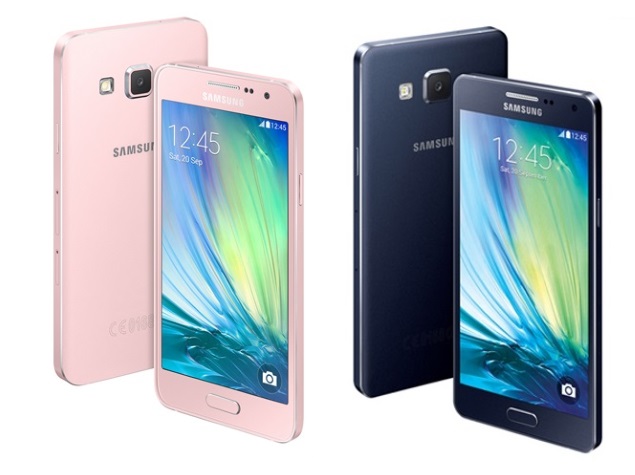- Home
- Mobiles
- Mobiles News
- Samsung Galaxy A3 and Galaxy A5 With Metal Build Launched
Samsung Galaxy A3 and Galaxy A5 With Metal Build Launched

Samsung's smartphone woes began late last year and persisted through July-September, with its global market share down on year for the third straight quarter and its profit scraping at a three-year low.
Its struggles were prominent in China, the world's biggest smartphone market, where Samsung was dethroned by local upstart Xiaomi Inc as the top smartphone maker in the second quarter. It does not help that Samsung's lower-end products are too expensive and not sufficiently distinctive compared to those touted by Xiaomi and Lenovo Group Ltd, analysts say.
The Galaxy A3 and Galaxy A5 are seen by analysts as Samsung's first counter-strike. Initially launching in China in November, they will be Samsung's first devices to feature fully metallic bodies and its thinnest smartphones to date. In size, the A3 and A5 are comparable to those of the top-of-the-line Galaxy S5 (Review | Pictures), though of lesser screen resolution quality.
"I think improving specs on the mid-tier products by using features like a full metal body is something that Samsung needed to do to respond to the Chinese rivals," said Seoul-based IBK Asset Management fund manager Kim Hyun-su, who holds Samsung shares.
Samsung classified the new phones as mid-tier, and said they will be launched in other "select markets", without disclosing the pricing.
The announcement, combined with hopes for an earnings recovery and bigger dividends, pushed Samsung's shares in Seoul to the highest close in more than two months. The stock has gained 10 percent since Thursday.
Line up revamp
Success for the devices remains to be seen in China and elsewhere as Samsung's rivals continue to make strides. In comparison to the A5, for example, Xiaomi's Mi4 device is thicker but sports a faster processor and a higher quality display.
"We'll have to wait and see how well these phones sell," said Seoul-based CIMB analyst Lee Do-hoon, adding that the lack of disclosure on pricing makes the devices' success harder to predict.
Samsung is expected to launch more devices in the near term. The company on Thursday admitted that it was too slow to respond to "rapid shifts in the competitive landscape" and vowed to deliver new products.
"For our mid to low-end smartphones we will enhance product competitiveness by differentiating our displays and materials as well as upgrading camera functionality," Senior Vice President Kim Hyun-joon told analysts on Thursday, pledging to take efforts to keep margins at double-digit rates going forward.
Such margins may be difficult to achieve, though. Global smartphone market growth is increasingly driven by the low-end segment, making it a race to the bottom for all but companies like Apple Inc that can still command a price premium.
Samsung has vowed to improve price competitiveness, as well, which will only further erode the bottom line. Most analysts do not expect a meaningful profit recovery for the firm's smartphone business until mid-2015 at the earliest, when the company may start seeing tangible results from a line-up revamp.
"A line-up change is a costly process, just like re-doing your home interior design," said KTB Investment analyst Jin Sung-hye.
© Thomson Reuters 2014
Get your daily dose of tech news, reviews, and insights, in under 80 characters on Gadgets 360 Turbo. Connect with fellow tech lovers on our Forum. Follow us on X, Facebook, WhatsApp, Threads and Google News for instant updates. Catch all the action on our YouTube channel.
Related Stories
- Samsung Galaxy Unpacked 2025
- ChatGPT
- Redmi Note 14 Pro+
- iPhone 16
- Apple Vision Pro
- Oneplus 12
- OnePlus Nord CE 3 Lite 5G
- iPhone 13
- Xiaomi 14 Pro
- Oppo Find N3
- Tecno Spark Go (2023)
- Realme V30
- Best Phones Under 25000
- Samsung Galaxy S24 Series
- Cryptocurrency
- iQoo 12
- Samsung Galaxy S24 Ultra
- Giottus
- Samsung Galaxy Z Flip 5
- Apple 'Scary Fast'
- Housefull 5
- GoPro Hero 12 Black Review
- Invincible Season 2
- JioGlass
- HD Ready TV
- Laptop Under 50000
- Smartwatch Under 10000
- Latest Mobile Phones
- Compare Phones
- Honor Win RT
- Honor Win
- Xiaomi 17 Ultra Leica Edition
- Xiaomi 17 Ultra
- Huawei Nova 15
- Huawei Nova 15 Pro
- Huawei Nova 15 Ultra
- OnePlus 15R
- Asus ProArt P16
- MacBook Pro 14-inch (M5, 2025)
- OPPO Pad Air 5
- Huawei MatePad 11.5 (2026)
- Xiaomi Watch 5
- Huawei Watch 10th Anniversary Edition
- Acerpure Nitro Z Series 100-inch QLED TV
- Samsung 43 Inch LED Ultra HD (4K) Smart TV (UA43UE81AFULXL)
- Asus ROG Ally
- Nintendo Switch Lite
- Haier 1.6 Ton 5 Star Inverter Split AC (HSU19G-MZAID5BN-INV)
- Haier 1.6 Ton 5 Star Inverter Split AC (HSU19G-MZAIM5BN-INV)



















